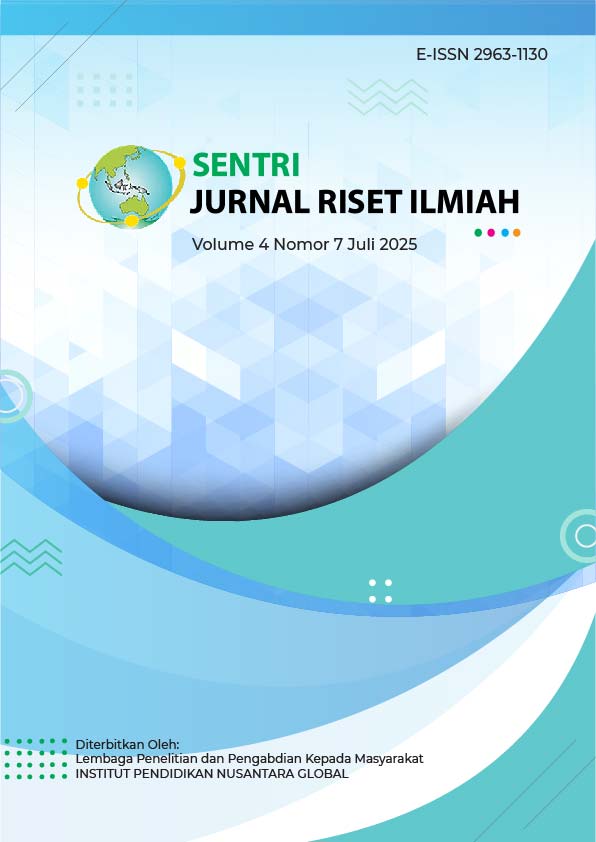Exploration of Pragmatic Strategies in a 3-Year-Old Child: A Psycholinguistic Perspective from Daily Interactions
DOI:
https://doi.org/10.55681/sentri.v4i7.4226Keywords:
psycholinguistics, pragmatics, child language developmentAbstract
This study employs a qualitative descriptive case‑study approach grounded in participatory observation of daily interactions, taped dialogue transcripts, and semi-structured parent interviews to analyze the pragmatic techniques of Zalva, a three-year-old child, through the lenses of Dardjowidjojo and Dworetzsky. By systematically coding and thematically analyzing naturalistic data, the research reveals that Zalva demonstrates sophisticated strategies such as giving advice, shifting topics, and offering reflective responses to social conventions. For instance, she counsels her father to refrain from consuming cold drinks and adeptly counters indirect criticism by asserting, “Zalva is occupied, please do not interrupt me.” These findings align with Dardjowidjojo’s emphasis on social and cultural interaction and Dworetzsky’s focus on cognitive adaptation in context. Practically, parents are encouraged to model directive and reflective speech acts during routine exchanges, while early‑childhood educators can incorporate role‑play and guided dialogue activities to foster children’s pragmatic competence. Future research should extend this case‑study framework to diverse cultural settings to deepen our understanding of early pragmatic development and its applications in educational and caregiving contexts.
Downloads
References
Braun, V., & Clarke, V. (2006). Using thematic analysis in psychology. Qualitative Research in Psychology, 3(2), 77–101. https://doi.org/10.1191/1478088706qp063oa
Bungin, B. (2017). Metodologi penelitian kualitatif: Aktualisasi metode kualitatif ke dalam penelitian ilmiah. Kencana.
Cameron, D. (2001). Working with spoken discourse. Sage Publications.
Clark, E. V. (2009). First language acquisition (2nd ed.). Cambridge University Press.
Dardjowidjojo, S. (2000). Psikolinguistik: Pengantar pemahaman bahasa manusia. Yayasan Obor Indonesia.
Dworetzky, J. P. (1988). Introduction to child development (5th ed.). West Publishing Company.
Gudykunst, W. B., & Ting-Toomey, S. (1988). Culture and interpersonal communication. Sage Publications.
Kecskes, I. (2014). Intercultural pragmatics. Oxford University Press.
Markus, H. R., & Kitayama, S. (1991). Culture and the self: Implications for cognition, emotion, and motivation. Psychological Review, 98(2), 224–253. https://doi.org/10.1037/0033-295X.98.2.224
Miles, M. B., & Huberman, A. M. (1994). Qualitative data analysis: An expanded sourcebook (2nd ed.). Sage Publications.
Moleong, L. J. (2014). Metodologi penelitian kualitatif (edisi revisi). Remaja Rosdakarya.
Patton, M. Q. (2002). Qualitative research and evaluation methods (3rd ed.). Sage Publications.
Snow, C. E. (1999). Social perspectives on the emergence of language. In B. MacWhinney (Ed.), The emergence of language (pp. 257–276). Lawrence Erlbaum Associates.
Sugiyono. (2017). Metode penelitian kualitatif, kuantitatif, dan R&D. Alfabeta.
Tomasello, M. (2003). Constructing a language: A usage-based theory of language acquisition. Harvard University Press.
Walsh, S. (2011). Exploring classroom discourse: Language in action. Routledge.
Yin, R. K. (2003). Case study research: Design and methods (3rd ed.). Sage Publications.
Downloads
Published
How to Cite
Issue
Section
License
Copyright (c) 2025 Jefriyanto Saud, Zainal Rafli, Fathiaty Murtadho

This work is licensed under a Creative Commons Attribution-ShareAlike 4.0 International License.









